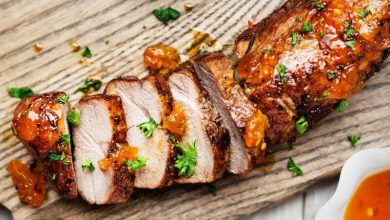🍚 Asian Risotto: A Delicious Fusion Dish 🍜
Asian Risotto is a fusion dish that combines the creamy and comforting aspects of Italian risotto with the vibrant and aromatic flavors of Asian cuisine. It’s a delightful marriage of two culinary traditions that results in a unique and delicious meal.
📜 History:
The exact origin of Asian Risotto is a bit challenging to pinpoint, but it likely emerged as part of the global trend of blending diverse culinary traditions. This fusion concept is in line with modern gastronomy, which encourages creativity and experimentation in the kitchen. The creamy consistency of risotto, combined with Asian ingredients and flavors, creates a harmonious and memorable dining experience.
🥘 Components:
-
Rice: Arborio or Carnaroli rice, traditionally used in Italian risotto, is the base. However, you can experiment with other short-grain rice varieties.
-
Broth: A flavorful broth, such as chicken or vegetable, forms the foundation of the dish. For an Asian twist, you can use a broth infused with ingredients like lemongrass, ginger, or miso.
-
Asian Ingredients: This is where the fusion magic happens. Ingredients like soy sauce, sesame oil, fresh ginger, garlic, green onions, and a variety of vegetables like shiitake mushrooms, edamame, or bok choy are often used to infuse Asian flavors.
-
Protein: You can add protein of your choice, such as shrimp, chicken, tofu, or even thinly sliced beef. Marinate or season the protein with Asian spices for an extra kick.
-
Aromatics: Fresh herbs like cilantro, Thai basil, or mint, and aromatic spices like star anise or five-spice powder can elevate the dish’s fragrance.
👩🍳 Steps to Prepare Asian Risotto:
-
Preparation: Gather your ingredients and prepare them. Chop the vegetables, mince the garlic and ginger, and marinate the protein if using.
-
Sauté Aromatics: In a large skillet or pan, heat some oil (sesame or vegetable) over medium heat. Sauté the minced garlic and ginger until fragrant.
-
Rice and Broth: Add the Arborio rice and stir to coat it in the aromatics. Then, start adding the Asian-infused broth one ladle at a time, stirring frequently. Allow the liquid to be mostly absorbed before adding more. This gradual process creates the creamy texture of risotto.
-
Asian Flavors: As you continue to add broth, incorporate the Asian ingredients, like soy sauce, sesame oil, and vegetables. Adjust the seasoning to your taste.
-
Protein: When the rice is almost cooked, add your choice of protein and cook until it’s done. Shrimp and thinly sliced beef cook quickly, while chicken or tofu may take a bit longer.
-
Finish and Serve: Remove the pan from heat, stir in fresh herbs, and top with additional Asian-inspired garnishes. Serve hot.
⏲️ Time Needed:
The total time needed to prepare Asian Risotto typically ranges from 30 to 45 minutes, depending on your cooking speed and choice of protein. The key is to ensure the rice is cooked to a creamy consistency while maintaining the vibrant flavors of the Asian ingredients.
Enjoy your Asian Risotto, a delightful fusion of two distinct culinary worlds! 🍲🥢🌟
🍚 Asian Risotto: Nutrition Facts and Health Information 🍜
Asian Risotto is a delicious fusion dish that offers a mix of flavors and ingredients, and its nutritional profile can vary depending on the specific ingredients and portion sizes. Here’s a general overview of the nutrition and health aspects to consider:
🥦 Nutrition Profile (per serving, approximately 1 cup):
- Calories: About 300-400 calories, depending on the ingredients and portion size.
- Protein: Can range from 10-20 grams, depending on the choice of protein (shrimp, chicken, tofu, etc.).
- Carbohydrates: Typically 40-60 grams, primarily from rice and vegetables.
- Fat: Around 10-15 grams, with variations based on the use of oils and protein sources.
- Fiber: Approximately 2-4 grams, mainly from the vegetables and rice.
- Sodium: The sodium content can be high due to soy sauce and other seasonings. It’s advisable to use reduced-sodium soy sauce to control sodium intake.
- Vitamins and Minerals: Asian Risotto may provide vitamins and minerals like vitamin C, vitamin A, iron, and calcium, depending on the choice of vegetables and ingredients.
🍽️ Health Information:
- Portion Control: Be mindful of portion sizes, as Asian Risotto can be calorie-dense. Smaller portions can help control calorie intake.
- Balanced Meal: Consider serving Asian Risotto with a side of steamed or stir-fried vegetables to increase fiber and micronutrient content.
- Protein Choices: Opt for lean protein sources like chicken or tofu for a lower saturated fat content.
- Sodium Awareness: Be cautious about the sodium content, especially if you’re watching your salt intake. Reduced-sodium soy sauce is a good option.
- Nutrient Variety: Vary the vegetables and ingredients to ensure a wide range of nutrients in your meal.
Remember that the specific nutrition facts can vary based on the ingredients and proportions you use in your Asian Risotto. For precise information tailored to your recipe, it’s recommended to use a nutrition calculator or consult a registered dietitian.




